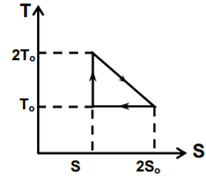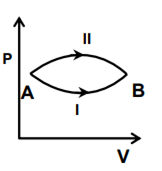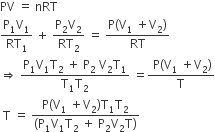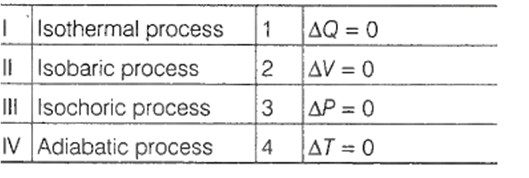 Multiple Choice Questions
Multiple Choice QuestionsThe temperature-entropy diagram of a reversible engine cycle is given in the figure. Its efficiency is
1/2
1/4
1/3
1/3
A system goes from A to B via two processes I and II as shown in the figure. If ∆U1 and ∆U2 are the changes in internal energies in the processes I and II respectively, the
∆U1 = ∆U2
relation between ∆U1 and ∆U2 can not be determined
∆U2 > ∆U1
∆U2 > ∆U1
Which of the following statements is correct for any thermodynamic system?
The internal energy changes in all processes.
Internal energy and entropy are state functions.
The change in entropy can never be zero.
The change in entropy can never be zero.
Two thermally insulated vessels 1 and 2 are filled with air at temperatures (T1, T2), volume (V1, V2) and pressure (P1, P2) respectively. If the valve joining two vessels is opened, the temperature inside the vessel at equilibrium will be
T1 + T2
T1 + T2/2


C.

There will be no change in number of moles if the vessels are joined by the valve. Therefore, from gas equation
Now, according to Boyle's law (pressure = constant) P1 V1 + P2 V2 = P(V1 + V2 )
Two moles of an ideal monoatomic gas occupies a volume V at 27°C. The gas expands adiabatically to a volume 2 V. Calculate (a) the final temperature of the gas and (b) change in its internal energy.
(a) 195 K (b) 2.7 kJ
(a) 189 K (b) 2.7 kJ
(a) 195 K (b) –2.7 kJ
(a) 189 K (b) – 2.7 kJ
Match the following

I-4, II-3, III-2, IV-1
I-3, II-2, III-1, IV-4
I-1, II-2, III-3, IV-4
I-4, II-2, III-3, IV-1
The Zeroth law of thermodynamics leads to the concept of
internal energy
heat content
pressure
temperature
The Carnot cycle of a reversible heat engine consists of
one isothermal and two adiabatic processes
two isothermal and one adiabatic processes
two isothermal and two adiabatic processes
two isobaric and two isothermal processes
A rigid container with thermally insulated walls contains a gas and a coil of resistance 50 Ω, carrying a current of 1 A. The change in internal energy of the gas after 2 min will be
6 kJ
10 kJ
3 kJ
12 kJ
Two soap bubbles each with radius r1 and r2 coalesce in vacuum under isothermal conditions to form a bigger bubble of radius R. Then, R is equal to
r1 + r2
